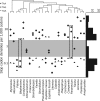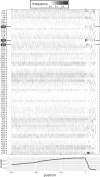Novel Ciliate Genetic Code Variants Including the Reassignment of All Three Stop Codons to Sense Codons in Condylostoma magnum
- PMID: 27501944
- PMCID: PMC5062323
- DOI: 10.1093/molbev/msw166
Novel Ciliate Genetic Code Variants Including the Reassignment of All Three Stop Codons to Sense Codons in Condylostoma magnum
Abstract
mRNA translation in many ciliates utilizes variant genetic codes where stop codons are reassigned to specify amino acids. To characterize the repertoire of ciliate genetic codes, we analyzed ciliate transcriptomes from marine environments. Using codon substitution frequencies in ciliate protein-coding genes and their orthologs, we inferred the genetic codes of 24 ciliate species. Nine did not match genetic code tables currently assigned by NCBI. Surprisingly, we identified a novel genetic code where all three standard stop codons (TAA, TAG, and TGA) specify amino acids in Condylostoma magnum We provide evidence suggesting that the functions of these codons in C. magnum depend on their location within mRNA. They are decoded as amino acids at internal positions, but specify translation termination when in close proximity to an mRNA 3' end. The frequency of stop codons in protein coding sequences of closely related Climacostomum virens suggests that it may represent a transitory state.
Keywords: alternative genetic decoding; ciliates; stop codon reassignment; the genetic code; translation termination.
© The Author 2016. Published by Oxford University Press on behalf of the Society for Molecular Biology and Evolution.
Figures



References
-
- Baranov PV, Atkins JF, Yordanova MM. 2015. Augmented genetic decoding: global, local and temporal alterations of decoding processes and codon meaning. Nat Rev Genet. 16:517–529. - PubMed
-
- Crick FH. 1968. The origin of the genetic code. J Mol Biol. 38:367–379. - PubMed
-
- Feng JM, Jiang CQ, Warren A, Tian M, Cheng J, Liu GL, Xiong J, Miao W. 2015. Phylogenomic analyses reveal subclass Scuticociliatia as the sister group of subclass Hymenostomatia within class Oligohymenophorea. Mol Phylogenet Evol. 90:104–111. - PubMed
Publication types
MeSH terms
Substances
Grants and funding
LinkOut - more resources
Full Text Sources
Other Literature Sources

